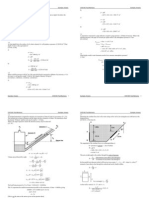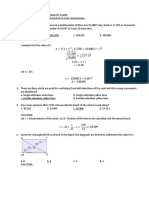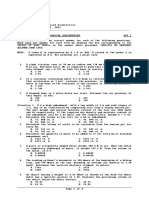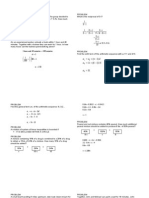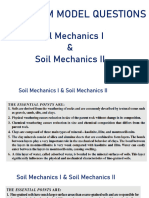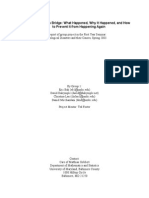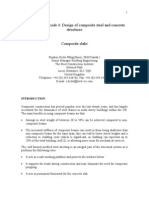100%(4)100% found this document useful (4 votes)
2K viewsCivil Engineering Reviewer - Soil and Foundation
Civil Engineering Reviewer - Soil and Foundation
Uploaded by
mark_torreonThe document contains a civil engineering review exam with 44 multiple choice questions covering topics in soil and foundation engineering. Some key topics assessed include soil classification, particle size distribution, consistency limits, permeability, compaction, consolidation, shear strength, and bearing capacity. Correct answers are provided for each question to test understanding of fundamental soil mechanics concepts and properties.
Copyright:
© All Rights Reserved
Available Formats
Download as DOCX, PDF, TXT or read online from Scribd
Civil Engineering Reviewer - Soil and Foundation
Civil Engineering Reviewer - Soil and Foundation
Uploaded by
mark_torreon100%(4)100% found this document useful (4 votes)
2K views8 pagesThe document contains a civil engineering review exam with 44 multiple choice questions covering topics in soil and foundation engineering. Some key topics assessed include soil classification, particle size distribution, consistency limits, permeability, compaction, consolidation, shear strength, and bearing capacity. Correct answers are provided for each question to test understanding of fundamental soil mechanics concepts and properties.
Original Description:
sda
Copyright
© © All Rights Reserved
Available Formats
DOCX, PDF, TXT or read online from Scribd
Share this document
Did you find this document useful?
Is this content inappropriate?
The document contains a civil engineering review exam with 44 multiple choice questions covering topics in soil and foundation engineering. Some key topics assessed include soil classification, particle size distribution, consistency limits, permeability, compaction, consolidation, shear strength, and bearing capacity. Correct answers are provided for each question to test understanding of fundamental soil mechanics concepts and properties.
Copyright:
© All Rights Reserved
Available Formats
Download as DOCX, PDF, TXT or read online from Scribd
Download as docx, pdf, or txt
100%(4)100% found this document useful (4 votes)
2K views8 pagesCivil Engineering Reviewer - Soil and Foundation
Civil Engineering Reviewer - Soil and Foundation
Uploaded by
mark_torreonThe document contains a civil engineering review exam with 44 multiple choice questions covering topics in soil and foundation engineering. Some key topics assessed include soil classification, particle size distribution, consistency limits, permeability, compaction, consolidation, shear strength, and bearing capacity. Correct answers are provided for each question to test understanding of fundamental soil mechanics concepts and properties.
Copyright:
© All Rights Reserved
Available Formats
Download as DOCX, PDF, TXT or read online from Scribd
Download as docx, pdf, or txt
You are on page 1of 8
At a glance
Powered by AI
The key takeaways are the concepts of effective stress, factors that affect soil strength and stability like uniformity, and methods to determine water content in soils.
The effective stress is the stress borne by the soil particles and is a function of total stress and pore water pressure. The total stress is the stress applied on the soil mass including the pore water pressure.
A uniform soil has more strength and stability than a non-uniform soil. Other factors like density, compaction, and water content also affect soil strength.
CIVIL ENGINEERING REVIEWER
SOIL AND FOUNDATION
1) A fully saturated soil is said to be
a. two phase system with soil and air
b. three phase system
c. one phase system
d. two phase system with soil and water
2) In hydrometer analysis for a soil mass
a. both meniscus correction and dispersing agent correction are additive
b. meniscus correction is additive and dispersing agent correction is
subtractive.
c. meniscus correction is subtractive and dispersing agent correction is additive
d. both meniscus correction and dispersing agent correction are subtractive
3) Stokes Law is valid only if the size of particle is
a. greater than 0.2 mm
b. less than 0.0002 mm
c. between 0.2 mm and 0.0002 mm
d. all of the choices
4) If the plasticity index of the of a soil mass is zero, the soil is
a. sand
b. clay
c. silt
d. clayey silt
5) Select the correct statement
a. A uniform soil has more strength and stability than a non-uniform soil.
b. Uniformity coefficient does not affect strength and stability.
c. A uniform soil has less strength and stability than a non-uniform soil.
d. Uniformity coefficient of a poorly graded soil is more than that of a well
graded soil.
6) The hydrometer method of sedimentation analysis differs from the pipette analysis
mainly in
a. the method of taking observations
b. the method of preparation of soil suspension
c. the principle of test
d. all of the choices
7) If the volume of voids is equal to the volume of solids in a soil mass, then the values
of porosity and void ratio respectively are
a. 0.5 and 1.0
b. 1.0 and 0.5
c. 1.0 and 0.0
d. 0.0 and 1.0
8) For proper field control, which of the following method is best suited for quick
determination of water content of a soil mass?
a. sand bath method
b. alcohol method
c. calcium carbide method
d. oven drying method
9) When the plastic limit of a soil is greater than the liquid limit, then the plasticity index
is reported as
a. one
b. non-plastic (NP)
c. zero
d. negative
10) Water content of soil can
a. be greater than 100%
b. take values only from 0% to 100%
c. be less than 0%
d. never be greater than 100%
11) At liquid limit, all soils possess
a. different shear strengths of large magnitude
b. same shear strength of large magnitude
c. same shear strength of small magnitude
d. different shear strengths of small magnitude
12) The admixture of coarser particles like sand or silt to clay causes
a. decrease in liquid limit and no change in plasticity index
b. decrease in both liquid limit and plasticity index
c. decrease in liquid limit and increase in plasticity index
d. increase in both liquid limit and plasticity index
13) Uniformity coefficient of a soil is
a. always equal to 1
b. equal to or greater than 1
c. equal to or less than 1
d. always less than 1
14) Select the correct range of density index, ID
a. ID > 0
b. ID > 1
c. 0 < ID <1
d. none of the choices
15) Effective stress is
a. a physical parameter that can be measured
b. important because it is a function of engineering properties of soil
c. the stress at particles in contact
d. all of the choices
16) The clay mineral with the largest swelling and shrinkage characteristics is
a. kaolinite
b. montmorillonite
c. illite
d. none of the choices
17) A pycnometer is used to determine
a. water content and specific gravity
b. void ratio and dry density
c. specific gravity and dry density
d. water content and void ratio
18) Dispersed type of soil structure is an arrangement comprising particles having
a. edge-to-face orientation
b. face-to-face or parallel orientation
c. face-to-edge orientation
d. all of the choices
19) If the sand in-situ is in its densest state, then the relative density of sand is
a. greater than 1
b. between 0 and 1
c. zero
d. one
20) A soil has a bulk density of 22 kN/m
3
and water content of 10%. The dry density of
soil is
a. 23.2 kN/m
3
b. 22.0 kN/m
c. 18.6 kN/m
3
d. 20.0 kN/m
3
21) Rise of water table in cohesionless soils up to ground surface reduces the net
ultimate bearing capacity approximately by
a. 75%
b. 25%
c. 90%
d. 50%
22) Contact pressure beneath a rigid footing resting on cohesive soil is
a. less at edges compared to middle
b. more at edges compared to middle
c. uniform throughout
d. none of the choices
23) Void ratio of a soil mass can
a. never be greater than unity
b. take values between 0 and 1 only
c. take any value greater than zero
d. none of the choices
24) If the water table rises up to ground surface, then the
a. total stress is increased due to decease in pore water pressure but effective
stress does not change
b. effective stress is reduced due to decrease in total stress only but pore water
pressure does not change
c. total stress is reduced due to increase in pore water pressure only but
effective stress does not change
d. effective stress is reduced due to increase in pore water pressure only
but total stress does not change.
25) If the natural water content of soil mass lies between its liquid limit and plastic limit,
the soil mass is said to be in
a. semi-solid state
b. plastic state
c. liquid state
d. solid state
26) Relative density of compacted dense sand is approximately equal to
a. 0.4
b. 0.95
c. 0.6
d. 1.20
27) Which of the following soils as more plasticity index?
a. gravel
b. clay
c. sand
d. silt
28) If the degree of saturation of a partially saturated soil is 60%, then air content of
the soil is
a. 60%
b. 100%
c. 80%
d. 40%
29) If the material of the base of the Casagrande liquid limit device on which the cup
containing soil paste drops is softer than the standard hard rubber, then
a. the liquid limit of soil always decreases
b. the liquid limit of soil may decrease
c. the liquid limit of soil always increases
d. the liquid limit of soil may increase
30) Sand particles are made of
a. montmorillonite
b. illite
c. kaolinite
d. rock minerals
31) Rise of water table above the ground surface causes
a. equal decrease in pore water pressure and total stress
b. decrease in pore water pressure but increase in total stress
c. equal increase in pore water pressure and total stress
d. decrease in pore water pressure but increase in total stress
32) The hydraulic head that would produce a quick condition in a sand stratum of
thickness 1.5 m, specific gravity 2.67 and voids ratio 0.67 is equal to
a. 2.0 m
b. 1.0 m
c. 3.0 m
d. 1.5 m
33) If the voids of a soil mass are full of air only, the soil is termed as
a. dehydrated soil
b. partially saturated soil
c. air entrained soil
d. dry soil
34) Toughness index is defined as the ratio of
a. plasticity index to flow index
b. liquidity index to flow index
c. plasticity index to consistency index
d. consistency index to liquidity index
35) Which of the following type of soil is transported by gravitational forces?
a. talus
b. drift
c. dune sand
d. loess
36) Which of the following methods is most accurate for the determination of the water
content of soil?
a. pycnometer method
b. sand bath method
c. calcium carbide method
d. oven drying method
37) Highway Research Board (HRB) classification of soils is based on
a. particle size composition
b. plasticity characteristics
c. both particle size composition and plasticity characteristics
d. none of the choices
38) If the water content of a fully saturated soil mass is 100%, then the void ratio of the
sample is
a. equal to specific gravity of soil
b. greater than specific gravity of soil
c. independent of specific gravity of soil
d. less than specific gravity of soil
39) Valid range for n, the percentage of voids, is
a. 0 < n < 100
b. n > 0
c. n < 0
d. none of the choices
40) The ratio of volume of voids to the total volume of soil mass is called
a. percentage air voids
b. air content
c. porosity
d. void ratio
41) According to Atterberg, the soil is said to of medium plasticity if the plasticity index
PI is
a. 17 < PI < 27
b. 0 < PI < 7
c. PI > 27
d. 7 < PI < 17
42) Which of the following is a measure of particle size range?
a. coefficient of curvature
b. effective size
c. none of the choices
d. uniformity coeficient
43) When the degree of saturation is zero, the soil mass under consideration
represents
a. two phase system with soil and air
b. two phase system with soil and water
c. three phase system
d. one phase system
44) Which of the following statements is correct?
a. For a well graded soil, both uniformity coefficient and coefficient of curvature
are nearly unity.
b. A soil is said to be well graded if it has most of the particles of about the
same size.
c. Uniformity coefficient represents the shape of the particle size distribution
curve.
d. none of the choices
45) Residual soils are formed by
a. glaciers
b. water
c. wind
d. none of the choices
46) Valid range for S, the degree of saturation of soil in percentage is
a. 0 < S < 100
b. S > 0
c. S < 0
d. none of the choices
47) Inorganic soil with low compressibility are represented by
a. SL
b. ML
c. CH
d. MH
48) The water content of soil, which represents the boundary between plastic and
liquid state, is known as
a. plastic limit
b. liquid limit
c. shrinkage limit
d. plasticity index
49) The total and effective stresses at a depth of 5 m below the top level of water in a
swimming pool are respectively
a. zero and 50 kg/cm
2
b. 0.5 kg/cm
2
and zero
c. 50 kg/cm
2
and 0.5 kg/cm
2
d. none of the choices
50) Select the correct statement
a. Unit weight of soil increases due to submergence in water.
b. For dry soils, dry unit weight is less than total unit weight.
c. Unit weight of soil decreases due to submergence in water.
d. Unit weight of dry soil is greater than unit weight of wet soil.
You might also like
- May 2019 Past Ce Board ExamDocument8 pagesMay 2019 Past Ce Board ExamHUSSEIN BACARAMAN83% (6)
- November 2018 Civil Engineering Board ExamDocument17 pagesNovember 2018 Civil Engineering Board ExamMaynard Baral91% (22)
- Mathematics Formulas For CE Board ExamDocument19 pagesMathematics Formulas For CE Board ExamAllan Bautista100% (4)
- Fluid Mechanic AnswerDocument32 pagesFluid Mechanic AnswerIser88% (41)
- Rce Hge Preboard FinalDocument8 pagesRce Hge Preboard FinalMecy Ann RectraNo ratings yet
- (XPERTZ) Preboard Exam 1ST HGE Nov 2022Document9 pages(XPERTZ) Preboard Exam 1ST HGE Nov 2022Fely Joy RelatoresNo ratings yet
- Past Board Objective Question HgeDocument10 pagesPast Board Objective Question HgeAndrea Magtuto100% (1)
- Past Board Objective Questions (Hge) 2015 Degree of Saturation UniformDocument8 pagesPast Board Objective Questions (Hge) 2015 Degree of Saturation UniformAndrea MagtutoNo ratings yet
- Review Civil EngineeringDocument103 pagesReview Civil EngineeringNico Geotina82% (11)
- Chua Ebooks Ce Review Planner PDFDocument68 pagesChua Ebooks Ce Review Planner PDFadam dam jhegs100% (1)
- Ce Board Exam May 2016 Geotechnical Engineering and HydraulicsDocument16 pagesCe Board Exam May 2016 Geotechnical Engineering and HydraulicsAmanda Smith100% (2)
- CHUA MAY 2018 CE BOARD EXAM MATH SOURCES AND SOLUTIONS PART 1 of 2 PDFDocument16 pagesCHUA MAY 2018 CE BOARD EXAM MATH SOURCES AND SOLUTIONS PART 1 of 2 PDFRizpah Pantig Balingit100% (1)
- CMD220413 1Document3 pagesCMD220413 1urkabitaNo ratings yet
- Hydraulics Reviewer For Civil Engineering StudentsDocument2 pagesHydraulics Reviewer For Civil Engineering StudentsKing BangngayNo ratings yet
- 04-Module 4 Preboard Solutions-FinalDocument7 pages04-Module 4 Preboard Solutions-FinalFerly May Zabala VillezaNo ratings yet
- May 2017 1Document5 pagesMay 2017 1Setsumii ShiizukaaNo ratings yet
- Bsce Quarantine Reviewer Diagnostic Exams Solutions and RefDocument73 pagesBsce Quarantine Reviewer Diagnostic Exams Solutions and Refcebep math pilipinas0% (1)
- 00 Calculator Techniques 01Document2 pages00 Calculator Techniques 01vincelord93% (14)
- Ce RefresherDocument142 pagesCe RefresherRenan Yanzon89% (9)
- PRACTICE PROBLEM No. 4 (Engineering Economy)Document9 pagesPRACTICE PROBLEM No. 4 (Engineering Economy)AaRichard ManaloNo ratings yet
- Nov 2019Document10 pagesNov 2019Axmeiksoww100% (2)
- CE Board Exam 1995Document25 pagesCE Board Exam 1995AaRichard Manalo100% (5)
- Civil Engineering Board Exam 2018 Schedule, Coverage, RequirementsDocument1 pageCivil Engineering Board Exam 2018 Schedule, Coverage, RequirementsLucille Samson ReyesNo ratings yet
- 50 Hydraulics Probs by Engr. Ben DavidDocument43 pages50 Hydraulics Probs by Engr. Ben DavidEly Jane DimaculanganNo ratings yet
- Mste 1 Algebra and Trigonometry No Answers RevisedDocument10 pagesMste 1 Algebra and Trigonometry No Answers RevisedChristy Mae LabajoNo ratings yet
- CE Board Exam 1998Document17 pagesCE Board Exam 1998AaRichard Manalo100% (1)
- Construction MethodsDocument12 pagesConstruction MethodsAndrea MagtutoNo ratings yet
- Topic 5 DamsDocument38 pagesTopic 5 DamsMerwin Andrew UyNo ratings yet
- Solved Probs in Hydro R by Eng'r. Ben David PDFDocument46 pagesSolved Probs in Hydro R by Eng'r. Ben David PDFMarkVincentTulinao100% (1)
- Board Exam Problems-MathDocument11 pagesBoard Exam Problems-MathAngela Mae Francisco100% (1)
- Module 1.1 - Introduction To RCDDocument34 pagesModule 1.1 - Introduction To RCDDopias FakeNo ratings yet
- Math Surveying TranspoDocument11 pagesMath Surveying TranspoMarichu Davillo GarbilesNo ratings yet
- Hge Set 1-09-02Document4 pagesHge Set 1-09-02Ice DelevingneNo ratings yet
- Geo Problem Set 2Document27 pagesGeo Problem Set 2Marielle Jane B. TapangNo ratings yet
- Math Coaching1 1stbooklet (FINAL)Document15 pagesMath Coaching1 1stbooklet (FINAL)Yael FabayosNo ratings yet
- E VV VS: CE Review - Geotechnical EngineeringDocument10 pagesE VV VS: CE Review - Geotechnical EngineeringJella DulatreNo ratings yet
- Ce Reviewer DesignDocument18 pagesCe Reviewer DesignZherrinore Rasay55% (11)
- Problem For PracticeDocument7 pagesProblem For PracticeJayLord Mico PacisNo ratings yet
- 50CDocument6 pages50Cjhacademyhyd89% (9)
- Mathematics Enhancement Through Calculator TechniquesDocument25 pagesMathematics Enhancement Through Calculator TechniquesJunar Amaro60% (5)
- Preboard 1Document19 pagesPreboard 1Sean WasilNo ratings yet
- May 2011 Board Exam All SubjectsDocument10 pagesMay 2011 Board Exam All SubjectsNarcisa Rudnic86% (14)
- MCQ Ge-1Document16 pagesMCQ Ge-1Mahesh Ramteke100% (1)
- Soil Mechanics (With Answer)Document17 pagesSoil Mechanics (With Answer)TrailokyaNo ratings yet
- Current Affairs Q&A PDF Free - November 2018 by AffairsCloudDocument27 pagesCurrent Affairs Q&A PDF Free - November 2018 by AffairsCloudSubham NayakNo ratings yet
- Soil MCQsDocument16 pagesSoil MCQsAli Raza100% (2)
- Soil Mechanics and Foundation MCQDocument15 pagesSoil Mechanics and Foundation MCQtarun23007No ratings yet
- Soil Mechanics MCQDocument48 pagesSoil Mechanics MCQGanapathy GanaNo ratings yet
- Ge - 1 MCQDocument20 pagesGe - 1 MCQlakshmidileepNo ratings yet
- Soil MechnicsDocument6 pagesSoil Mechnicsyoni gemechuNo ratings yet
- PANA Crash Course Chapter 2 Soil Mechanics and Foundation Eng.Document109 pagesPANA Crash Course Chapter 2 Soil Mechanics and Foundation Eng.hellobunny234No ratings yet
- Exit ExamDocument158 pagesExit ExamMarken AbelNo ratings yet
- Atterberg Limits ProblemsDocument7 pagesAtterberg Limits ProblemschmaojtNo ratings yet
- Exit ExamDocument64 pagesExit ExamTadesse MegersaNo ratings yet
- Mechanics of Soils-2marksDocument30 pagesMechanics of Soils-2marksPraveenkumar ShanmugamNo ratings yet
- Copy Civil Eng Paper 2 JuneDocument35 pagesCopy Civil Eng Paper 2 JuneSamiullah M QaisraniNo ratings yet
- Multiple Choice QuestionscivilDocument19 pagesMultiple Choice Questionscivilashish kushNo ratings yet
- SOIL GEOTECH QUEDocument18 pagesSOIL GEOTECH QUERAVI KANT VermaNo ratings yet
- Multiple Choice Question GeotechnicsDocument2 pagesMultiple Choice Question GeotechnicszamzuraneeNo ratings yet
- GATE IIT (GT Test - 1)Document3 pagesGATE IIT (GT Test - 1)RadhaAnanthalekshmiNo ratings yet
- Geotech Engineering: Er. Sandip BudhathokiDocument48 pagesGeotech Engineering: Er. Sandip BudhathokiranjitNo ratings yet
- Soils as a Key Component of the Critical Zone 3: Soils and Water CirculationFrom EverandSoils as a Key Component of the Critical Zone 3: Soils and Water CirculationGuilhem BourriéNo ratings yet
- Advanced Placement Sentence PatternsDocument9 pagesAdvanced Placement Sentence Patternsmark_torreonNo ratings yet
- CEDocument207 pagesCEmark_torreonNo ratings yet
- Group 1 TacomaDocument10 pagesGroup 1 Tacomamark_torreonNo ratings yet
- Nteractive Rice Alculator: Size MM Weight KG/M Price Per Length Price Per KG 6.0 7.5 9.0 10.5 12.0Document2 pagesNteractive Rice Alculator: Size MM Weight KG/M Price Per Length Price Per KG 6.0 7.5 9.0 10.5 12.0mark_torreonNo ratings yet
- SketchesDocument3 pagesSketchesmark_torreonNo ratings yet
- Rizal's EssaysDocument2 pagesRizal's Essaysmark_torreonNo ratings yet
- Rizal MonumentDocument5 pagesRizal Monumentmark_torreonNo ratings yet
- Paintings: Date of Creation Title Place of Creation Material Description/RemarksDocument1 pagePaintings: Date of Creation Title Place of Creation Material Description/Remarksmark_torreonNo ratings yet
- From Codex RizalDocument39 pagesFrom Codex Rizalmark_torreonNo ratings yet
- CorrespondenceDocument53 pagesCorrespondencemark_torreonNo ratings yet
- Jose Rizal 2Document22 pagesJose Rizal 2mark_torreonNo ratings yet
- The Carnegie Nobody KnowsDocument10 pagesThe Carnegie Nobody Knowsmark_torreonNo ratings yet
- Jose Rizal 1Document20 pagesJose Rizal 1mark_torreonNo ratings yet
- Procedure Checklist - ASTM C143Document1 pageProcedure Checklist - ASTM C143mark_torreonNo ratings yet
- Building Strengthening Techniques and Construction MethodsDocument12 pagesBuilding Strengthening Techniques and Construction MethodsMihai NistorNo ratings yet
- The Civil Engineering Licensure Examination SyllabiDocument9 pagesThe Civil Engineering Licensure Examination Syllabiapi-281795875100% (1)
- En 1994 - Eurocode 4: Design ofDocument24 pagesEn 1994 - Eurocode 4: Design ofchono_kolevNo ratings yet
- Structural Investigation Report - Magellan's Cross ChurchDocument4 pagesStructural Investigation Report - Magellan's Cross Churchmark_torreonNo ratings yet
- Procedure Checklist - ASTM C31Document1 pageProcedure Checklist - ASTM C31mark_torreonNo ratings yet
- A Framework For Understanding Uncertainty and Its Mitigation and Exploitation in Complex SystemsDocument20 pagesA Framework For Understanding Uncertainty and Its Mitigation and Exploitation in Complex Systemsmark_torreonNo ratings yet
- Practical Year Logbook For Students in The Term: OphthalmologyDocument20 pagesPractical Year Logbook For Students in The Term: OphthalmologyDimpi DeviNo ratings yet
- StorefrontsDocument12 pagesStorefrontsAntonio SomeraNo ratings yet
- PFI-ES-01 (2001) IntMachBackRingsButtsDocument8 pagesPFI-ES-01 (2001) IntMachBackRingsButtsdon_romanticko281236No ratings yet
- Passfab 4winDocument3 pagesPassfab 4winAdisu GaromaNo ratings yet
- PMI - PMP Prep Questions - 2Document16 pagesPMI - PMP Prep Questions - 2kavitha karuppanaNo ratings yet
- New Phytologist - 2004 - Bond - The Global Distribution of Ecosystems in A World Without FireDocument14 pagesNew Phytologist - 2004 - Bond - The Global Distribution of Ecosystems in A World Without FireAhmad AlawiNo ratings yet
- GHANA ELECTION PETITION Full PDFDocument588 pagesGHANA ELECTION PETITION Full PDFSackey SosiNo ratings yet
- Pespective: Scale NTSDocument1 pagePespective: Scale NTSJayson Ayon MendozaNo ratings yet
- 3.CE130 Lecture 3Document22 pages3.CE130 Lecture 3Jon JimmyNo ratings yet
- Global Smartwatch Shipments Market Share Q2 2021 Q4 2022Document2 pagesGlobal Smartwatch Shipments Market Share Q2 2021 Q4 2022chensilvia777No ratings yet
- 2017 12 Economics Sample Paper 02 QPDocument3 pages2017 12 Economics Sample Paper 02 QPahmadshahwaqarNo ratings yet
- TNJFU - Non-Teaching Positions - AdvertisementDocument2 pagesTNJFU - Non-Teaching Positions - AdvertisementGiridharan SubramaniamNo ratings yet
- Public SuperSim CalcDocument3 pagesPublic SuperSim CalcPatrick FederissiNo ratings yet
- Grammar Test: Choose The Correct Answers To Complete The SentencesDocument4 pagesGrammar Test: Choose The Correct Answers To Complete The SentencesDraganNo ratings yet
- 2NGB001236 PCM600 2.12 Hotfix 20230213 Release Note - A ID 4537Document3 pages2NGB001236 PCM600 2.12 Hotfix 20230213 Release Note - A ID 4537JADSON SOUZANo ratings yet
- Sales Management - Mgt304Document17 pagesSales Management - Mgt304meetpalNo ratings yet
- Tandem Axle Machine PPT1 PDFDocument9 pagesTandem Axle Machine PPT1 PDFSaurabh GourNo ratings yet
- What Is Ethics and ValuesDocument7 pagesWhat Is Ethics and ValuesPOTNURU RAM SAI 21BCE9010No ratings yet
- 12 Ict Group 3 Chapter - 1Document24 pages12 Ict Group 3 Chapter - 1alliahdane valenciaNo ratings yet
- Tube Turns Hinged ClosureDocument8 pagesTube Turns Hinged ClosureMarcelino Torres RenjfoNo ratings yet
- Revalida - 4. Cha Vs CADocument2 pagesRevalida - 4. Cha Vs CADonna Joyce de BelenNo ratings yet
- Quiz 001 - Attempt Review4 PDFDocument3 pagesQuiz 001 - Attempt Review4 PDFkatherine anne ortizNo ratings yet
- Enhance Privacy Search in Web Search Engine Using Greedy AlgorithmDocument4 pagesEnhance Privacy Search in Web Search Engine Using Greedy AlgorithmijsretNo ratings yet
- Professional Practice (Architecture)Document17 pagesProfessional Practice (Architecture)Riddhi PatelNo ratings yet
- Handout 2 - Introduction To Auditing and Assurance of Specialized IndustriesDocument2 pagesHandout 2 - Introduction To Auditing and Assurance of Specialized IndustriesPotato CommissionerNo ratings yet
- Weight of Copper Strip - Flat According To KG - MTRDocument3 pagesWeight of Copper Strip - Flat According To KG - MTRAkshay GatkalNo ratings yet
- ELECTRONIC DOCUMENT MANAGEMENT SYSTEM & SUBMITTALS Rev.1Document8 pagesELECTRONIC DOCUMENT MANAGEMENT SYSTEM & SUBMITTALS Rev.1mohdNo ratings yet
- UaDocument28 pagesUaSamuel SugiartoNo ratings yet



